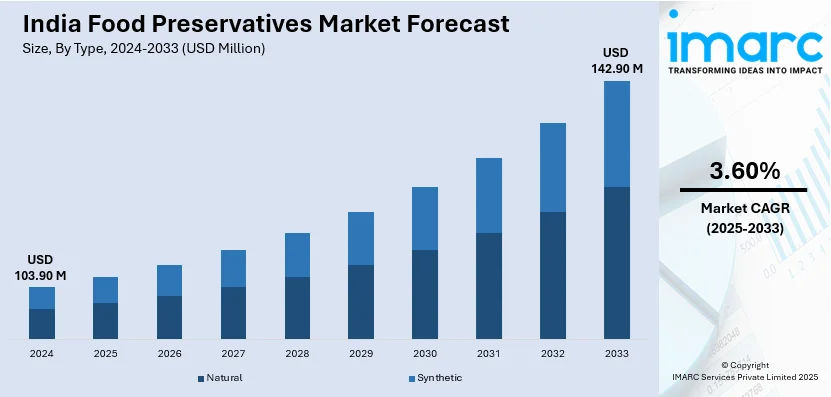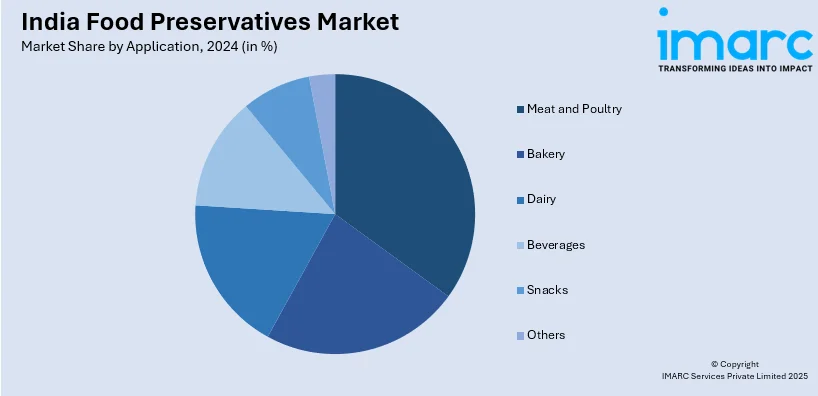
India Food Preservatives Market Size, Share, Trends and Forecast by Type, Function, Application, and Region, 2025-2033
India Food Preservatives Market Overview:
The India food preservatives market size reached USD 103.90 Million in 2024. Looking forward, IMARC Group expects the market to reach USD 142.90 Million by 2033, exhibiting a growth rate (CAGR) of 3.60% during 2025-2033. The market is driven by rising demand for processed and packaged foods due to urbanization and busy lifestyles. Increasing health awareness is enhancing the preference for natural preservatives. Government regulations promoting food safety and the expansion of e-commerce and retail channels further propel the India food preservatives market share.
|
Report Attribute
|
Key Statistics
|
|---|---|
|
Base Year
|
2024 |
|
Forecast Years
|
2025-2033
|
|
Historical Years
|
2019-2024
|
| Market Size in 2024 | USD 103.90 Million |
| Market Forecast in 2033 | USD 142.90 Million |
| Market Growth Rate 2025-2033 | 3.60% |
India Food Preservatives Market Trends:
Growing Demand for Natural Food Preservatives
The significant shift toward natural and clean-label preservatives, driven by increasing consumer awareness about health and wellness is majorly driving the India food preservatives market growth. Consumers are becoming more cautious about synthetic additives and their potential health risks, leading to a rise in demand for natural alternatives such as rosemary extract, vinegar, citric acid, and fermented ingredients. This trend is further supported by the rising popularity of organic and minimally processed foods. A research study indicates that rosemary extract improves the oxidative stability of peanut and African walnut oils, where concentrations (up to 1500 ppm) lead to a decrease in oxidation. The high phenolic content of the extract (33.72 mg EAE/g) is associated with its antioxidant properties, making it a promising alternative natural preservative to replace synthetic antimicrobial and antioxidant agents, catering to the increasing demand for healthier food preservation options in India. In addition, manufacturers are reformulating their products to replace synthetic preservatives including benzoates and sorbates with natural options to cater to health-conscious consumers. Additionally, government regulations and initiatives promoting clean eating are encouraging this transition. The natural preservatives segment is expected to grow at a robust pace, as food producers align with consumer preferences for safer, healthier, and more sustainable food options.

Expansion of the Processed and Packaged Food Industry
The rapid growth of India’s processed and packaged food industry is creating a positive India food preservatives market outlook. A research report from the IMARC Group indicates that the packaged food market in India was valued at USD 113.9 Billion in 2023. It is projected to grow to USD 210.81 Billion by 2032, reflecting a compound annual growth rate (CAGR) of 7.08% from 2024 to 2032. With rapid urbanization, changing lifestyles, and increasing disposable incomes, there is a growing reliance on ready-to-eat meals, snacks, and convenience foods. These products require effective preservation to extend shelf life and maintain quality, creating a strong demand for food preservatives. Additionally, the rise of e-commerce platforms and modern retail channels has made packaged foods more accessible to consumers across the country. Manufacturers are focusing on innovative preservation techniques to meet the demand for longer-lasting products without compromising on taste or nutritional value. This trend is particularly prominent in metropolitan areas, where busy schedules and dual-income households are fueling the consumption of processed foods, thereby enhancing the market.
India Food Preservatives Market Segmentation:
IMARC Group provides an analysis of the key trends in each segment of the market, along with forecasts at the country level for 2025-2033. Our report has categorized the market based on type, function, and application.
Type Insights:
- Natural
- Edible Oil
- Rosemary Extracts
- Natamycin
- Vinegar
- Others
- Synthetic
- Propionates
- Sorbates
- Benzoates
- Others
The report has provided a detailed breakup and analysis of the market based on the type. This includes natural (edible oil, rosemary extracts, natamycin, vinegar, and others), and synthetic (propionates, sorbates, benzoates, and others).
Function Insights:
- Anti-Microbial
- Anti-Oxidant
- Others
A detailed breakup and analysis of the market based on the function have also been provided in the report. This includes anti-microbial, anti-oxidant, and others.
Application Insights:

- Meat and Poultry
- Bakery
- Dairy
- Beverages
- Snacks
- Others
The report has provided a detailed breakup and analysis of the market based on the application. This includes meat and poultry, bakery, dairy, beverages, snacks, and others.
Regional Insights:
- North India
- South India
- East India
- West India
The report has also provided a comprehensive analysis of all the major regional markets, which include North India, South India, East India, and West India.
Competitive Landscape:
The market research report has also provided a comprehensive analysis of the competitive landscape. Competitive analysis such as market structure, key player positioning, top winning strategies, competitive dashboard, and company evaluation quadrant has been covered in the report. Also, detailed profiles of all major companies have been provided.
India Food Preservatives Market News:
- September 10, 2024: The FSSAI recommended the inclusion of Natamycin as an allowed preservative in India's food rules, permitting 5 mg/kg of it in fermented milk and dairy desserts. The natural antifungal agent is designed to help prolong shelf life and prevent the proliferation of mould and yeast in fermented dairy products.
- September 10, 2024: Syensqo launched a 100 percent plant-based formulation of its Riza, a range of natural antioxidants and flavors derived from rosemary, all set to deliver to changing demands for natural food preservatives in India. The product line includes both rosemary extract and mixtures, powder, and liquid, specially created to protect omega-3 fatty acids, flavor, and color in foods. With ethically sourced ingredients from Morocco, this launch aligns with the trend in India's food sector towards the use of more natural components.
India Food Preservatives Market Report Coverage:
| Report Features | Details |
|---|---|
| Base Year of the Analysis | 2024 |
| Historical Period | 2019-2024 |
| Forecast Period | 2025-2033 |
| Units | Million USD |
| Scope of the Report |
Exploration of Historical Trends and Market Outlook, Industry Catalysts and Challenges, Segment-Wise Historical and Future Market Assessment:
|
| Types Covered |
|
| Functions Covered | Anti-Microbial, Anti-Oxidant, Others |
| Applications Covered | Meat and Poultry, Bakery, Dairy, Beverages, Snacks, Others |
| Regions Covered | North India, South India, East India, West India |
| Customization Scope | 10% Free Customization |
| Post-Sale Analyst Support | 10-12 Weeks |
| Delivery Format | PDF and Excel through Email (We can also provide the editable version of the report in PPT/Word format on special request) |
Key Questions Answered in This Report:
- How has the India food preservatives market performed so far and how will it perform in the coming years?
- What is the breakup of the India food preservatives market on the basis of type?
- What is the breakup of the India food preservatives market on the basis of function?
- What is the breakup of the India food preservatives market on the basis of application?
- What is the breakup of the India food preservatives market on the basis of region?
- What are the various stages in the value chain of the India food preservatives market?
- What are the key driving factors and challenges in the India food preservatives market?
- What is the structure of the India food preservatives market and who are the key players?
- What is the degree of competition in the India food preservatives market?
Key Benefits for Stakeholders:
- IMARC’s industry report offers a comprehensive quantitative analysis of various market segments, historical and current market trends, market forecasts, and dynamics of the India food preservatives market from 2019-2033.
- The research report provides the latest information on the market drivers, challenges, and opportunities in the India food preservatives market.
- Porter's five forces analysis assist stakeholders in assessing the impact of new entrants, competitive rivalry, supplier power, buyer power, and the threat of substitution. It helps stakeholders to analyze the level of competition within the India food preservatives industry and its attractiveness.
- Competitive landscape allows stakeholders to understand their competitive environment and provides an insight into the current positions of key players in the market.
Need more help?
- Speak to our experienced analysts for insights on the current market scenarios.
- Include additional segments and countries to customize the report as per your requirement.
- Gain an unparalleled competitive advantage in your domain by understanding how to utilize the report and positively impacting your operations and revenue.
- For further assistance, please connect with our analysts.
 Inquire Before Buying
Inquire Before Buying
 Speak to an Analyst
Speak to an Analyst
 Request Brochure
Request Brochure
 Request Customization
Request Customization




.webp)




.webp)












